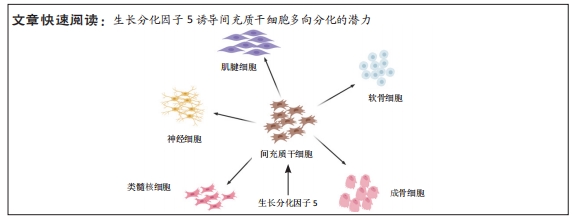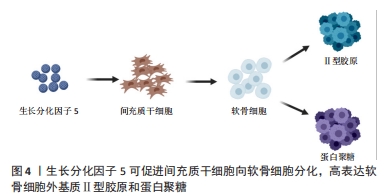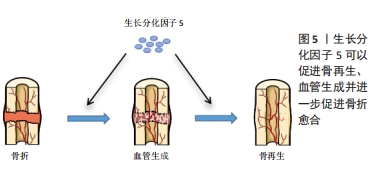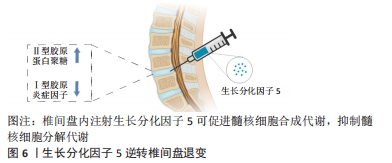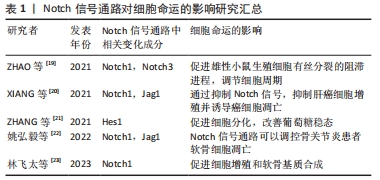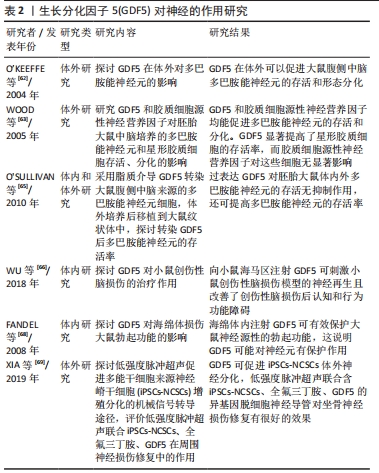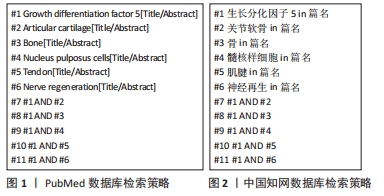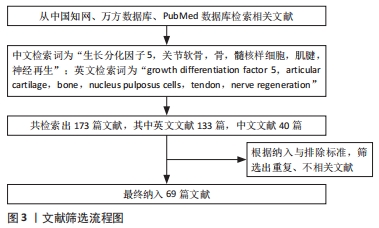[1] LIU H, RUI Y, LIU J, et al. Hyaluronic acid hydrogel encapsulated BMP-14-modified ADSCs accelerate cartilage defect repair in rabbits. J Orthop Surg Res. 2021;16(1):657.
[2] STORM EE, HUYNH TV, COPELAND NG, et al. Limb alterations in brachypodism mice due to mutations in a new member of the TGF beta-superfamily. Nature. 1994;368(6472):639-643.
[3] HÖTTEN G, NEIDHARDT H, JACOBOWSKY B, et al. Cloning and expression of recombinant human growth/differentiation factor 5. Biochem Biophys Res Commun. 1994;204(2):646-652.
[4] HELDIN CH, MIYAZONO K, TEN DIJKE P. TGF-beta signalling from cell membrane to nucleus through SMAD proteins. Nature. 1997;390(6659):465-471.
[5] PARK A, HOGAN MV, KESTURU GS, et al. Adipose-derived mesenchymal stem cells treated with growth differentiation factor-5 express tendon-specific markers. Tissue Eng Part A. 2010;16(9):2941-2951.
[6] JIMI E, FEI H, NAKATOMI C. NF-κB Signaling Regulates Physiological and Pathological Chondrogenesis. Int J Mol Sci. 2019;20(24):6275.
[7] MACKAY AM, BECK SC, MURPHY JM, et al. Chondrogenic differentiation of cultured human mesenchymal stem cells from marrow. Tissue Eng. 1998; 4(4):415-428.
[8] COLEMAN CM, VAUGHAN EE, BROWE DC, et al. Growth differentiation factor-5 enhances in vitro mesenchymal stromal cell chondrogenesis and hypertrophy. Stem Cells Dev. 2013;22(13):1968-1976.
[9] HAN C, REN Y, JIA Y, et al. The effective mode of growth and differentiation factor-5 in promoting the chondrogenic differentiation of adipose-derived stromal cells. Cell Tissue Bank. 2016;17(1):105-115.
[10] CUI Y, YAO M, LIU Y, et al. Effects of cartilage-derived morphogenetic protein 1 (CDMP1) transgenic mesenchymal stem cell sheets in repairing rabbit cartilage defects. Genet Mol Res. 2016;15(2). doi: 10.4238/gmr.15028058.
[11] ZHU K, ZHAO R, YE Y, et al. Effect of lentivirus-mediated growth and differentiation factor-5 transfection on differentiation of rabbit nucleus pulposus mesenchymal stem cells. Eur J Med Res. 2022;27(1):5.
[12] LOUGHLIN J. Genetic contribution to osteoarthritis development: current state of evidence. Curr Opin Rheumatol. 2015;27(3):284-288.
[13] DAANS M, LUYTEN FP, LORIES RJ. GDF5 deficiency in mice is associated with instability-driven joint damage, gait and subchondral bone changes. Ann Rheum Dis. 2011;70(1):208-213.
[14] PARRISH WR, BYERS BA, SU D, et al. Intra-articular therapy with recombinant human GDF5 arrests disease progression and stimulates cartilage repair in the rat medial meniscus transection (MMT) model of osteoarthritis. Osteoarthritis Cartilage. 2017;25(4):554-560.
[15] 李明辉,刘洋,孙凯,等.生长分化因子5诱导脂肪干细胞向软骨细胞的转化[J].中国组织工程研究,2016,20(51):7628-7633.
[16] 杨亚军. CDMP1诱导ADSCs修复软骨损伤的实验研究[D].西安:第四军医大学,2008.
[17] KAKUDO N, WANG YB, MIYAKE S, et al. Analysis of osteochondro-induction using growth and differentiation factor-5 in rat muscle. Life Sci. 2007;81(2): 137-143.
[18] MARUYAMA M, RHEE C, UTSUNOMIYA T, et al. Modulation of the Inflammatory Response and Bone Healing. Front Endocrinol (Lausanne). 2020;11:386.
[19] COLEMAN CM, SCHEREMETA BH, BOYCE AT, et al. Delayed fracture healing in growth differentiation factor 5-deficient mice: a pilot study. Clin Orthop Relat Res. 2011;469(10):2915-2924.
[20] DALY AC, FREEMAN FE, GONZALEZ-FERNANDEZ T, et al. 3D Bioprinting for Cartilage and Osteochondral Tissue Engineering. Adv Healthc Mater. 2017;6(22).
[21] YANG J, ZHANG YS, YUE K, et al. Cell-laden hydrogels for osteochondral and cartilage tissue engineering. Acta Biomater. 2017;57:1-25.
[22] AMINI AR, LAURENCIN CT, NUKAVARAPU SP. Bone tissue engineering: recent advances and challenges. Crit Rev Biomed Eng. 2012;40(5):363-408.
[23] ZENG Q, LI X, BECK G, et al. Growth and differentiation factor-5 (GDF-5) stimulates osteogenic differentiation and increases vascular endothelial growth factor (VEGF) levels in fat-derived stromal cells in vitro. Bone. 2007; 40(2):374-381.
[24] CHENG X, YANG T, MENG W, et al. Overexpression of GDF5 through an adenovirus vector stimulates osteogenesis of human mesenchymal stem cells in vitro and in vivo. Cells Tissues Organs. 2012;196(1):56-67.
[25] MENDES LF, KATAGIRI H, TAM WL, et al. Advancing osteochondral tissue engineering: bone morphogenetic protein, transforming growth factor, and fibroblast growth factor signaling drive ordered differentiation of periosteal cells resulting in stable cartilage and bone formation in vivo. Stem Cell Res Ther. 2018;9(1):42.
[26] CHHABRA A, ZIJERDI D, ZHANG J, et al. BMP-14 deficiency inhibits long bone fracture healing: a biochemical, histologic, and radiographic assessment. J Orthop Trauma. 2005;19(9):629-634.
[27] DEGENKOLBE E, SCHWARZ C, OTT CE, et al. Improved bone defect healing by a superagonistic GDF5 variant derived from a patient with multiple synostoses syndrome. Bone. 2015;73:111-119.
[28] HASENBEIN I, SACHSE A, HORTSCHANSKY P, et al. Single Application of Low-Dose, Hydroxyapatite-Bound BMP-2 or GDF-5 Induces Long-Term Bone Formation and Biomechanical Stabilization of a Bone Defect in a Senile Sheep Lumbar Osteopenia Model. Biomedicines. 2022;10(2):513.
[29] 张勇.生长分化因子-5诱导人脂肪基质细胞成骨的实验研究[D].北京:解放军医学院,2010.
[30] KLEINSCHMIDT K, WAGNER-ECKER M, BARTEK B, et al. Superior angiogenic potential of GDF-5 and GDF-5(V453/V456) compared with BMP-2 in a rabbit long-bone defect model. J Bone Joint Surg Am. 2014;96(20):1699-1707.
[31] XIAO D, YANG F, ZHAO Q, et al. Fabrication of a Cu/Zn co-incorporated calcium phosphate scaffold-derived GDF-5 sustained release system with enhanced angiogenesis and osteogenesis properties. RSC Adv. 2018;8(52): 29526-29534.
[32] BUNGARTZ M, KUNISCH E, MAENZ S, et al. GDF5 significantly augments the bone formation induced by an injectable, PLGA fiber-reinforced, brushite-forming cement in a sheep defect model of lumbar osteopenia. Spine J. 2017;17(11):1685-1698.
[33] ZHANG C, YANG F, XIAO D, et al. Repair of segmental rabbit radial defects with Cu/Zn co-doped calcium phosphate scaffolds incorporating GDF-5 carrier. RSC Adv. 2020;10(4):1901-1909.
[34] WANG H, ZHOU Y, CHU TW, et al. Distinguishing characteristics of stem cells derived from different anatomical regions of human degenerated intervertebral discs. Eur Spine J. 2016;25(9):2691-2704.
[35] COLOMBINI A, LOMBARDI G, CORSI MM, et al. Pathophysiology of the human intervertebral disc. Int J Biochem Cell Biol. 2008;40(5):837-842.
[36] PATIL P, NIEDERNHOFER LJ, ROBBINS PD, et al. Cellular senescence in intervertebral disc aging and degeneration. Curr Mol Biol Rep. 2018;4(4): 180-190.
[37] LV B, GAN W, CHENG Z, et al. Current Insights Into the Maintenance of Structure and Function of Intervertebral Disc: A Review of the Regulatory Role of Growth and Differentiation Factor-5. Front Pharmacol. 2022;13:842525.
[38] FENG C, LIU H, YANG Y, et al. Growth and differentiation factor-5 contributes to the structural and functional maintenance of the intervertebral disc. Cell Physiol Biochem. 2015;35(1):1-16.
[39] LUO XW, LIU K, CHEN Z, et al. Adenovirus-mediated GDF-5 promotes the extracellular matrix expression in degenerative nucleus pulposus cells. J Zhejiang Univ Sci B. 2016;17(1):30-42.
[40] YANG Z, GAO XJ, ZHAO X. CDMP1 promotes type II collagen and aggrecan synthesis of nucleus pulposus cell via the mediation of ALK6. Eur Rev Med Pharmacol Sci. 2020;24(21):10975-10983.
[41] LI X, LEO BM, BECK G, et al. Collagen and proteoglycan abnormalities in the GDF-5-deficient mice and molecular changes when treating disk cells with recombinant growth factor. Spine (Phila Pa 1976). 2004;29(20):2229-2234.
[42] SHEN L, WU Y, HAN L, et al. Overexpression of growth and differentiation factor-5 inhibits inflammatory factors released by intervertebral disc cells. Exp Ther Med. 2018;15(4):3603-3608.
[43] YUAN B, RUDEEN K, LI J, et al. Biodegradable Microspheres and Hydrogel Drug Delivery System of Tumor Necrosis Factor (TNF) Inhibitor and Growth Differentiation Factor 5 (GDF5) Reduces Disc Inflammation in the Rabbit Model. Spine (Phila Pa 1976). 2023 Apr 17. doi: 10.1097/BRS.0000000000004686.
[44] XU H, SUN M, WANG C, et al. Growth differentiation factor-5-gelatin methacryloyl injectable microspheres laden with adipose-derived stem cells for repair of disc degeneration. Biofabrication. 2020;13(1):015010.
[45] STOYANOV JV, GANTENBEIN-RITTER B, BERTOLO A, et al. Role of hypoxia and growth and differentiation factor-5 on differentiation of human mesenchymal stem cells towards intervertebral nucleus pulposus-like cells. Eur Cell Mater. 2011;21:533-547.
[46] MINOGUE BM, RICHARDSON SM, ZEEF LA, et al. Transcriptional profiling of bovine intervertebral disc cells: implications for identification of normal and degenerate human intervertebral disc cell phenotypes. Arthritis Res Ther. 2010;12(1):R22.
[47] WANG Z, WU Y, ZHAO Z, et al. Study on Transorgan Regulation of Intervertebral Disc and Extra-Skeletal Organs Through Exosomes Derived From Bone Marrow Mesenchymal Stem Cells. Front Cell Dev Biol. 2021;9: 741183.
[48] HU A, XING R, JIANG L, et al. Thermosensitive hydrogels loaded with human-induced pluripotent stem cells overexpressing growth differentiation factor-5 ameliorate intervertebral disc degeneration in rats. J Biomed Mater Res B Appl Biomater. 2020;108(5):2005-2016.
[49] ZHU J, XIA K, YU W, et al. Sustained release of GDF5 from a designed coacervate attenuates disc degeneration in a rat model. Acta Biomater. 2019;86:300-311.
[50] GUO S, CUI L, XIAO C, et al. The Mechanisms and Functions of GDF-5 in Intervertebral Disc Degeneration. Orthop Surg. 2021;13(3):734-741.
[51] 侯凯,李梅,李金茹,等.体外诱导大鼠脂肪源间充质干细胞成肌腱潜能的研究[J].中国现代医学杂志,2011,21(8):929-933.
[52] 刘真,张浩然.生长分化因子-5对间充质干细胞向肌腱细胞分化及迁移潜能影响的相关研究[J].中国医学创新,2021,18(20):28-32.
[53] WANG D, JIANG X, LU A, et al. BMP14 induces tenogenic differentiation of bone marrow mesenchymal stem cells in vitro. Exp Ther Med. 2018;16(2): 1165-1174.
[54] FITZGERALD MJ, MUSTAPICH T, LIANG H, et al. Tendon Transection Healing Can Be Improved With Adipose-Derived Stem Cells Cultured With Growth Differentiation Factor 5 and Platelet-Derived Growth Factor. Hand (N Y). 2023;18(3):436-445.
[55] DE ARO AA, CARNEIRO GD, TEODORO LFR, et al. Injured Achilles Tendons Treated with Adipose-Derived Stem Cells Transplantation and GDF-5. Cells. 2018;7(9):127.
[56] QU Y, ZHOU L, LV B, et al. Growth differentiation factor‑5 induces tenomodulin expression via phosphorylation of p38 and promotes viability of murine mesenchymal stem cells from compact bone. Mol Med Rep. 2018;17(3):3640-3646.
[57] RICKERT M, JUNG M, ADIYAMAN M, et al. A growth and differentiation factor-5 (GDF-5)-coated suture stimulates tendon healing in an Achilles tendon model in rats. Growth Factors. 2001;19(2):115-126.
[58] HASSLUND S, DADALI T, ULRICH-VINTHER M, et al. Freeze-dried allograft-mediated gene or protein delivery of growth and differentiation factor 5 reduces reconstructed murine flexor tendon adhesions. J Tissue Eng. 2014;5:2041731414528736.
[59] BOLT P, CLERK AN, LUU HH, et al. BMP-14 gene therapy increases tendon tensile strength in a rat model of Achilles tendon injury. J Bone Joint Surg Am. 2007;89(6):1315-1320.
[60] GOULDING SR, ANANTHA J, COLLINS LM, et al. Growth differentiation factor 5: a neurotrophic factor with neuroprotective potential in Parkinson’s disease. Neural Regen Res. 2022;17(1):38-44.
[61] TYSNES OB, STORSTEIN A. Epidemiology of Parkinson’s disease. J Neural Transm (Vienna). 2017;124(8):901-905.
[62] O’KEEFFE GW, DOCKERY P, SULLIVAN AM. Effects of growth/differentiation factor 5 on the survival and morphology of embryonic rat midbrain dopaminergic neurones in vitro. J Neurocytol. 2004;33(5):479-488.
[63] WOOD TK, MCDERMOTT KW, SULLIVAN AM. Differential effects of growth/differentiation factor 5 and glial cell line-derived neurotrophic factor on dopaminergic neurons and astroglia in cultures of embryonic rat midbrain. J Neurosci Res. 2005;80(6):759-766.
[64] SULLIVAN AM, O’KEEFFE GW. The role of growth/differentiation factor 5 (GDF5) in the induction and survival of midbrain dopaminergic neurones: relevance to Parkinson’s disease treatment. J Anat. 2005;207(3):219-226.
[65] O’SULLIVAN DB, HARRISON PT, SULLIVAN AM. Effects of GDF5 overexpression on embryonic rat dopaminergic neurones in vitro and in vivo. J Neural Transm (Vienna). 2010;117(5):559-572.
[66] WU H, LI J, XU D, et al. Growth Differentiation Factor 5 Improves Neurogenesis and Functional Recovery in Adult Mouse Hippocampus Following Traumatic Brain Injury. Front Neurol. 2018;9:592.
[67] GOULDING SR, CONCANNON RM, MORALES-PRIETO N, et al. Growth differentiation factor 5 exerts neuroprotection in an α-synuclein rat model of Parkinson’s disease. Brain. 20213;144(2):e14.
[68] FANDEL TM, BELLA AJ, LIN G, et al. Intracavernous growth differentiation factor-5 therapy enhances the recovery of erectile function in a rat model of cavernous nerve injury. J Sex Med. 2008;5(8):1866-1875.
[69] XIA B, CHEN G, ZOU Y, et al. Low-intensity pulsed ultrasound combination with induced pluripotent stem cells-derived neural crest stem cells and growth differentiation factor 5 promotes sciatic nerve regeneration and functional recovery. J Tissue Eng Regen Med. 2019;13(4):625-636. |
